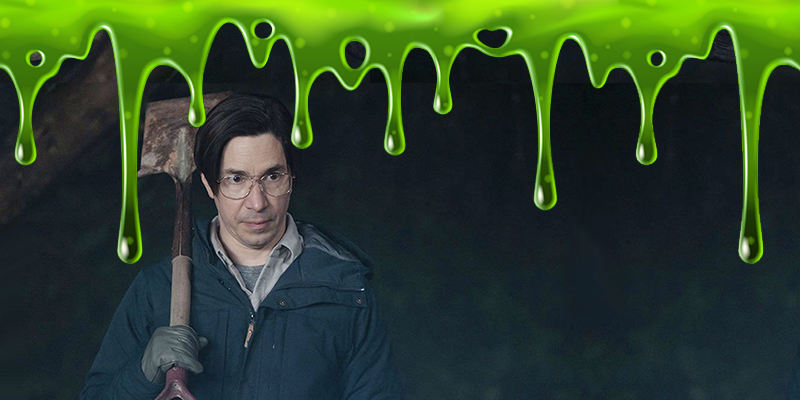Adapting a property like Goosebumps, R.L. Stine’s beloved series of children’s horror novels, for the big (or small) screen in 2023 is a tricky proposition. Each of the sixty-two books in the original run, apart from a handful of sequels, stands alone, so an anthology format, like the one adopted by the popular Canadian-produced television series from the 1990s, is a logical choice. But in the 21st century, an era of increasing serialization in all forms of media, the anthology has rather fallen out of favor (a few exceptions like Black Mirror notwithstanding). However, if one wanted to zero in on a specific story, a new challenge would arise: the individual books are fairly short and breezy, so they may not be able to support an entire film or TV season on their own. Besides, cherry-picking volumes from the canon inevitably leaves out many beloved tales that fans would want to see represented. Problems like these are likely why the first feature-length adaptation, 2015’s Goosebumps, directed by Rob Letterman, was an amalgamation of elements from several different Goosebumps books, a fascinating meta-exercise in which Jack Black plays author R.L. Stine himself, having to contend with the creatures from his books coming to life.
The new Disney+/Hulu series, entitled Goosebumps and developed by Letterman and Nicholas Stoller, tries something different, blending episodic and serialized elements in a way that honors the spirit of the source material while also creating something new and exciting. The show opens in 1993 in the Pacific Northwestern town of Port Lawrence, with the mysterious teenager Harold Biddle (Ben Cockell), who has a basement full of strange objects—a creepy mask, a tank full of worms, a scrapbook full of ominous drawings and scribbles, among other things. One night, an unseen presence at his home torments Harold, and he inadvertently starts a fire that claims his life.
Thirty years later, Biddle’s former house, now the object of town legends, has been inherited by the new-in-town high school English teacher, Nathan Bratt (Justin Long). But before he can get settled in, local high-schoolers—including football star Isaiah (Zack Morris), his eager-to-please best friend James (Miles McKenna), and his academic overachiever neighbor Margot (Isa Briones), as well as high-strung loner Isabella (Ana Yi Puig) and reckless screw-up Lucas (Will Price)—decide to throw a Halloween night rager at the infamous house. However, each one of them comes across a different cursed object of Biddle’s, which sets them all on a collision course with each other and with Biddle’s malevolent spirit, come back from the dead to exact vengeance on those who wronged him in life.
A Goosebumps series is nothing without scares, and while there’s no denying that on the whole, the show is relatively tame and accessible for a wider audience, it still captures a suitably eerie tone.Those aforementioned objects—a Polaroid camera that predicts dark futures, the mask which fuels its wearer’s darkest impulses, a cuckoo clock that traps its victim in a time loop, and the worms, which compel the susceptible to eat them—will be very familiar to long-time fans, as will the episode titles, which are all references to distinct books in the series (i.e. Say Cheese and Die!, The Haunted Mask, The Cuckoo Clock of Doom, and Go Eat Worms). Each of the early episodes of the season primarily focus on a different character, doubling back to the fateful party and following their subsequent experiences with the paranormal. This structure is an inspired choice, reminiscent of horror auteur Mike Flanagan’s Netflix shows that remix various entries in specific authors’ canons (i.e. The Haunting of Bly Manor adapting The Turn of the Screw but also elements from other Henry James texts, The Midnight Club incorporating several different Christopher Pike books, and The Fall of the House of Usher serving as a mash-up of the stories and poems of Edgar Allan Poe). It allows the show to adapt individual Goosebumps books within a serialized context, taking the iconic monsters or conceits and retro-fitting them for each teen’s personal arc. This way, fans get to see a wider spectrum of what they loved from the books while still delivering on a compelling ongoing narrative.
The subject matter is surprisingly mature at times, given its middle-grade roots. The original books always focused on the everyday life trials and tribulations of its tween and teenage protagonists (and by extension its readers) along with their supernatural problems, but the new series approaches these issues with relative sophistication and a more modern sensibility. Each character is dealing with the enormous pressures of high school, with Isaiah in particular struggling with his grades and a need to maintain his football career in order to receive a scholarship for college his family might not otherwise be able to afford. James’s need to be liked stems from being one of the only gay kids in a small town. Isabella’s alienation drives her to mock her classmates online as an anonymous troll. Margot has harbored a crush on Isaiah for years, but feels taken advantage of when he seems unable to choose between her and his girlfriend Allison (Rhinnan Payne). Lucas’s daredevil antics are borne out of his grief after having lost his father. This doesn’t even include their parents, like Margot’s father Colin (Rob Huebel), the high school guidance counselor, or Lucas’s mother Nora (Rachael Harris), the local diner owner, all of whom are experiencing a variety of adult issues, like spousal separation, widowhood, infidelity, among others.
The actors are all uniformly strong, with the young performers acquitting themselves very well; they are more than capable leads of the series, and their chemistry with each other is palpable. Morris and McKenna in particular have a very lived-in friendship on screen that feels real. Not all of the kids start off being close to one another, but once they begin to join forces to combat the forces plaguing them, the show really benefits from having all of their different conflicting personalities bouncing off one another. On some level, they are archetypes—the jock, the class clown, the nerd, etc.—but they are well-defined archetypes.
However, the series standout is undeniably Justin Long as Mr. Bratt, who at the end of the pilot becomes possessed by the spirit of Harold Biddle. This gives Long the license to go very big with his performance, as both the comically terrified Bratt and his archly villainous yet-socially-awkward new master; he flails around and stares uncomfortably at people, chomping on chocolate powder packets and bowls of worms with gleeful abandon. Long has a long (no pun intended) and illustrious career in horror, most recently featuring in 2022’s breakout hit Barbarian, so he’s a welcome sight in a more kid-friendly horror setting.
A Goosebumps series is nothing without scares, and while there’s no denying that on the whole, the show is relatively tame and accessible for a wider audience, it still captures a suitably eerie tone—one that may push the boundaries for its younger viewers. Biddle’s ghost frequently appears to people as a screaming, fiery specter, and Goosebumps also takes full advantage of the creepiness of inanimate objects, like the titular haunted mask, as well as a certain ventriloquist dummy that will undoubtedly excite fans of the books. But beyond the scares, Goosebumps also functions as a compelling mystery, with its young leads discovering that their parents may have played a part in the sins of the past and trying to unravel the conspiracy. If Riverdale was a take on Twin Peaks but for a younger audience, Goosebumps is on the same continuum, just for an even younger audience.
As a diehard childhood fan of the Goosebumps books, I approached the series with a certain level of caution. It’s a property I have a great deal of nostalgia for, but nostalgia that does not entail frequent revisiting (as I think of it as belonging firmly to my childhood). How would Goosebumps fare in this new format, in the cold light of adulthood? But the show both honors and updates the source material, in ways that I could still appreciate as an adult. Having each episode be an adaptation/remix of a new book allows the Disney+/Hulu series to have its cake and eat it too, in terms of different TV storytelling styles – a satisfying blend of familiar and fresh. Thankfully, with Goosebumps, viewers need not beware.

















